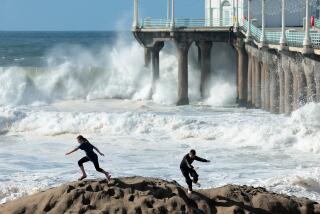The outer limits
When Jaws gets big, the earth shakes.
When Jaws gets big, ominous shadows are cast over the reef and everything else . . . gets really small.
When Jaws gets big, says veteran big-wave surfer Charlie Walker, “It can hold you down beyond what you’re capable of surviving.”
Waimea Bay, on Oahu’s infamous North Shore, has always been known as Hawaii’s most notorious big-wave break.
But now there is Jaws, a remote break on Maui that is slightly bigger, much hollower and more walled up--and potentially much deadlier--than Waimea.
“Nobody goes there but us,” says Darrick Doerner, 39, who with more than a hint of territorialism is referring to his small group of expert surfers who are pioneering the new and dangerous sport of power surfing, not only at Jaws but at other such mountainous outer-reef breaks, which until recently had been considered unsurfable.
Situated in deeper water than the inshore reefs, the outer reefs are the first obstacle for the massive swells generated by storms in the North Pacific. The speed of the swells, which are moving too fast to paddle into, creates massive peaks as they squeeze up against the reefs.
Using Jet Skis, or similar personal watercraft, the surfers have solved the access problem, and with tow-ropes they have discovered a way to catch the waves. The pilot of the craft tows the surfer into the face of the developing peak, then speeds out of harm’s way before the wave breaks and monitors the ride, ready to race in and pick up the surfer if he wipes out or gets caught inside.
Using custom boards, much shorter and narrower than the traditional big-wave “guns,” at about 7 1/2 feet long and 16 inches wide, weighted with lead and fitted with foot straps, the surfers have figured out how, in most cases, to avoid skipping down faces of skyscraper-size waves and being hurled over the falls and buried alive by a ton of whitewater.
“We call it power surfing,” Doerner says. “Surfing is surfing, but you can’t jump on a freight train with a bicycle. The machine is the power that puts us into these waves.”
And, using vast knowledge of the dynamics of island surf, gained from years of experience surfing big waves and rescuing others in deadly rips and thunderous impact zones, they have managed to stay alive.
So far.
“We’re either out there having fun or maybe we’re running from the tiger,” says Doerner, who has 20 years’ experience as a North Shore lifeguard. “You have to draw the line at what you do. We all want to see our lives grow a little longer.”
Doerner last winter caused the surfing world’s collective jaw to drop when he became the first to duck into a cavernous, grinding tube at Jaws--and got spit out still standing and able to talk about it.
“It was . . . the most perfect day we’ve had at Jaws,” he recalls, as vividly as though it were yesterday. “Barrels. Big barrels. Four- or five-story barrels. And I just saw an opportunity that my 35 years of surfing allowed me to see and I pulled in. Laird [Hamilton, his tow-in partner] and I had been ripping Jaws for a few years, but that day we cut the yellow ribbon and took this to a new level.”
And what a monster Doerner, Hamilton and Buzzy Kerbox, the pioneers, and their power-surfing companions have created.
Tow-in surfing, as it is also called, has become the rage in Hawaii. Anyone with access to a jet-powered vessel and surfboard can do it.
Or, as Walker says, “The sport does invite the rich-kook guy to do it. If he’s got money, all he needs is the machine, someone to drive it and he can go out there and try it. But if he gets into trouble, he can’t call his mother over to help him. He’s on his own.”
Tow-in surfing is appealing to older surfers as well, those who no longer have the stamina to paddle out in big waves and no longer wish to compete against younger, more aggressive surfers on crowded inshore breaks.
And this has lifeguards and others in surfing cringing, because they can look into the future and see the death-rate among surfers begin to climb.
“It’s kind of like the beauty and the beast,” says Brian Keaulana, 35, a longtime Oahu lifeguard famous for his surfing and life-saving exploits on the North Shore. “People understand the beauty of the waves but not the beast. The beast can rip you in half. You can die in a microsecond.
“In tow-in, you’re only as good as your backup. In tow-in surfing, one thing is guaranteed: That you are going to wipe out at some time. Most times you can’t get out [of the impact zone] on your own. Without that machine you’re history. It’s a gamble.”
Adds Randy Rarick, event director of the annual Triple Crown of surfing on Oahu’s North Shore: “Somebody is going to die. And I would be willing to bet that someone will die this year.”
Moot Ahquin, a water sports videographer from Laie on Oahu’s east shore, will not take that bet.
“Unfortunately, there’s a lot of guys out there who shouldn’t really be out there,” he says. “Some of these waves, like at Jaws, without exaggeration you can fit three or four buses stacked on top of each other inside.
“Most of those guys [Doerner and crew], they are ironmen, man. The optimum place to be to harness that power is halfway down the face, but that wave is chasing you. I think it was Gerry Lopez that said, ‘Surfing Waimea is like snowboarding down a mountain with an avalanche behind you.’ Well, can you imagine what surfing Jaws is like? It’s like having the whole mountain behind you.”
Terry Ahue, 44, a lifeguard who, with Doerner and Keaulana, runs a company that uses jet-powered personal watercraft to perform rescues at surf contests and other water-related events, says the problem stems not only from the size of the swells but from the fact that the power surfers are performing in areas where there are no lifeguards and, in many cases, no other people.
Ahue occasionally patrols Oahu’s outer reefs and says that because there is nothing illegal about what the surfers are doing, and that Hawaii’s lifeguards have no jurisdiction to order people out of the water anyway, he can only advise them as to the dangers they might be facing.
“They call me the sheriff,” he says. “It wasn’t real popular at first, but now all the old big-wave riders, it’s fun to them because they can catch a lot more waves. But the problem is, what happens after the guy tows you in? Are you able to survive?
“These waves are 30 feet. To me they look huge. I’m a little dot going down those things. I’m going, ‘Jesus, if I wipe out I’m history.’
“Somebody is going to get hurt, eventually. They’re way out at sea. A lot of them have never caught a 15-foot wave [waves are measured from the back and are nearly double in size from peak to trough], and they’re out there playing around like it’s nothing. They haven’t even started walking yet and they’re out there, only because of the craft, because it can get them out there and put them in the wave.
“The problem is, are you physically and mentally in shape enough for this? Because the ski only can tow you in. After that you’ve got to take the wipeout, and then you [on the Jet Ski] got to go in and try to grab him. And if you lose it on the Jet Ski, you all got to swim in miles. . . . They are miles out. The current, and the surf. . . . You’re a goner.”
Surfing-related deaths at the pounding inshore breaks such as Waimea are kept to a minimum--one or two a year--by the skill of the surfers who paddle out on big days, and by well-trained lifeguards, including helicopter crews and a team of expert Jet Ski riders who usually can pluck dazed surfers from the impact zone before the set of waves is through rolling in.
Such isn’t the case at the outer reefs.
Walker, an Oahu sander and longtime surfer who took up power surfing in 1994, had a near-fatal experience recently in fairly large surf at an offshore reef not far from his house on the North Shore.
There were three surfers aboard his 13-foot Sea-Doo Explorer, a driver, a spotter, and Walker the surfer. There also was another team of surfers at the reef.
“I got towed in and the wave was pretty fun, about 15 feet,” Walker recalls. “The wave ended and they had to give me a little space when they came in to get me. When they did so, the tow line had a loop in it and it wrapped around either my foot or my board cord [leash].
“It snagged me. Well, the second wave was a little bigger and it swung a little wider and as it was about to break they hit the throttle and I was being dragged under. I basically became a sea anchor. I had no knife, and there was no quick-release [mechanism] like there should have been. So I got dragged under.”
The craft wasn’t going anywhere so the driver and spotter jumped off and dived beneath the oncoming wave, which crashed thunderously on the boat. “I felt the drag and it started to pull me under, but you know what? We had an old tow rope and it broke . . . and that, I think, saved my life, so I was stoked.”
The Sea-Doo’s shell exploded under the impact of the wave. The ocean was littered with pieces of plastic and fiberglass. The three, with the assistance of the other team, managed to collect the vessel from the impact zone and as much of its shell as possible and tow it close to shore.
“I put the bow rope in my teeth and swam and towed the boat to the safest place to swim ashore,” Walker says. “We got most of the water out, took a four-wheel-drive and dragged it up the beach and across someone’s yard, gave it a flushing and it still runs.”
*
Though others may claim to be the first to tow someone into a wave with a boat or personal watercraft, Doerner, Hamilton and Kerbox, with a little help from board shapers and acquaintances, are credited with developing it, through test runs and innovative equipment modifications, into an actual sport.
Kerbox, 40, said it began in 1991 when he and Hamilton, in an attempt to get away from crowded inshore breaks, made their first visit, with traditional surfboards, to an outer Oahu reef on a souped-up 15-foot inflatable boat with a 40-horsepower outboard.
“Laird and I did it several times and we were getting the hang of it, and then one day it got real big and Darrick was with us and we went out,” Kerbox recalls. “The three of us rode those waves and it was then that we really realized the full potential. We all had the waves of our lives, and it was an incredible experience. It was also at that point when a photographer in a helicopter captured what we were doing.”
The photos appeared in a surfing magazine and the controversy started brewing as to whether what these professional surfers were doing was surfing, or cheating. Purists brought up the fact that using a machine to pull one into the face of a wave that is moving too fast to catch by paddling is more than cheating, it’s polluting the pristine waters around the reefs.
That same argument is being made today, and the response on the part of the tow-in crowd is also the same.
“Yes, it is a machine, with a two-stroke engine that burns oil, and, yes, it is noisy,” Walker says. “But it puts you in places that you have never experienced. Why waste a wave? Waves are nice to look at, but why not be on them instead? In a matter of a few minutes you can be at an entirely new break.”
True enough. It is this fact that is also responsible for more people taking up power surfing.
Because they can tow the surfer into the easy part of the wave, on the outside shoulder, or into the middle of the peak, they can choose the level of risk they wish to take.
Because they can be towed in to waves of any size, some are beginning to steal waves of conventional surfers at smaller inshore breaks, driving a wedge of anger between the groups.
Doerner believes the situation is getting out of control.
“Laird and I had the whole North Shore to ourselves, and those guys were talking bad about us and they were sick and jealous because we were riding waves for two miles, and now they’re out there,” he says. “They’d be at Waimea, 100 yards out and everybody is going straight, and they would look outside and they saw us on little tiny surfboards and we’re maneuvering all over the waves.
“What they don’t know is, we have certain rules. Rule No. 1, never tow around surfers. We go to the outer reefs, and you don’t see us and you don’t smell us. We have always respected their right to those waves, we respect that wholly. But not out here [anymore]. Guys haven’t the slightest clue what respect is. They’re running around all over the place.”
The power-surfing controversy peaked a few weeks ago when it was announced that the inaugural Jaws Invitational would be held this month.
Jaws (locals call it Peahi after the valley that funnels trade winds down to the sea) is the only place still ridden by only occasional wind-surfers and a select and very territorial crew of experienced tow-in surfers: Doerner, Hamilton, Kerbox, Dave Kalama, Rush Randle, Pete Cabrinha, Mark Angulo, Brett Lickle, Mike Waltze, and a few others.
The plan, according to Handsome Bugga Productions, a Maui-based water-sports events promoter, was to have 16 of the world’s top professional surfers compete in what would be an annual televised event.
The contest recently was put on hold for a year, though, because of opposition on a couple of fronts.
The Jaws crew boycotted the event, complaining to one another that it would exploit their break and put young hot-shots in a spotlight that belongs to them, and claiming publicly that most of the surfers on the list, despite their experience with conventional surfing, would be in over their heads at 20-foot-plus Jaws.
The strongest opposition, however, came from Sony Pictures in Culver City, which is in the final stages of filming a movie about three surfers who go through life “discovering who they are,” producer Tom Stern says, with the ultimate objective of getting to and power-surfing Jaws. (Keaulana, Doerner and a few other Jaws regulars, who did much of the stunt work in Kevin Costner’s “Waterworld,” will have similar roles in the movie.)
Rather than fight Sony over who has the right to put a film crew in the water when the next swell hits, Rodney Kilborn, Handsome Bugga president, decided it would be best to wait a year.
But he defended his right to hold the contest and scoffs at protests by some claiming that by offering as incentive a pot of $100,000, with $35,000 going to the winner, it would turn a dangerous situation into a potentially deadly one by enticing participants to ask to be towed deeper into the face of the developing peak for a more dramatic performance, perhaps inside a snarling tube from which there might be no escape.
“When men have to use a machine to get somewhere to accomplish something, you are trusting your life with that machine,” Kilborn says. “The reason for that machine is, without it, you physically yourself cannot do this. Just like the space shuttle and the astronauts that go to the moon. They need a machine and they take tremendous risks. Just like race car driving, that is another machine and these guys race at tremendous velocities. It’s called living on the edge, and that is what these guys are doing here. . . .
“Besides, the guys we picked are the elite. It’s not like we’re asking Pete, Tom and Jane to be in this event. It’s not like we’re walking down the beach and passing out entry forms. We’re very comfortable with who we have selected, and we’re not twisting any arms.”
That, it seems, would be left to Jaws.
More to Read
Sign up for our L.A. Times Plants newsletter
At the start of each month, get a roundup of upcoming plant-related activities and events in Southern California, along with links to tips and articles you may have missed.
You may occasionally receive promotional content from the Los Angeles Times.






